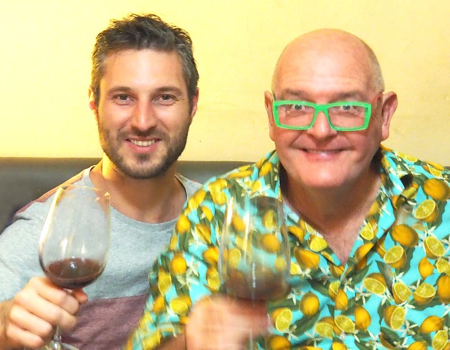Thankfully, I’m on the other side of my first episode of acute low back pain, just like the majority of the general population. But I got a good look at why for so many, acute pain can become persistent, disabling, life-changing pain.
When it happened

Someone or something needs to blamed right? I blame the person who wanted to buy my little boat, but eventually didn’t. Preparing for the sale that didn’t happen involved some early morning cleaning and a routine check, but this somehow got me into trouble. Not unusual to have some back pain after physical effort, but something obviously strong enough to get my alarm system pissed off – immediate referred pain everywhere, impossible to bend, could hardly walk and I struggled to get myself back in the car…
I diagnosed myself with acute non-specific low back pain. I planned to be back on my feet within a week. And I was.
With a little help from “friends”?
However, it didn’t get better because of the positive comments in my surroundings…
I wrote down some of the stand-out comments
“Bart… are you ok? You look like you’re shitting your pants!”
“Bart… it should have been better by now..?!” (patient)
“Bart… you should do more sport” (colleague 1)
“Bart… you’re getting older…” (colleague 2)
“Bart… you shouldn’t be at work” (colleague 3)
“Bart… I bet you think it is all in your head, right?” (colleague 4)
“Bart… is it still so bad? It must be something with you discs” (colleague 3 again)
“Daddy… When is your back ok again, I want to play horsey”
“Darling… you should take the car rather than the bike”
Even though my practice is pretty up to date and aware of pain sciences, the truly inner thoughts and beliefs need a bit of adjustment!
See you in Eemnes
He guys! Join me on a course, or check out my NOI Netherlands shop for Begrijp de Pijn 2de Editie!!
 Bart lives in Haarlem, The Netherlands, where he works in private multidisciplinary practice (Praktijk Noorder Spaarne) and specialises in treating and supporting people with chronic pain. Bart is responsible for founding the NOI Faculty in the Netherlands and together with Mark Langerhorst he translated the ‘Explain Pain’ text into Dutch. Bart has completed his Masters in Physiotherapy and is enrolled in a PhD program working on the development of an Explain Pain curriculum for clinicians and patients. This research includes a RCT in a CBT + Explain Pain intervention in order to fit the Explain Pain approach into the usual care program of a multidisciplinary pain centre. Bart teaches physiotherapy both at undergraduate and postgraduate level with a focus on pain topics and as a NOI teacher he teaches Explain Pain courses across the Netherlands.
Bart lives in Haarlem, The Netherlands, where he works in private multidisciplinary practice (Praktijk Noorder Spaarne) and specialises in treating and supporting people with chronic pain. Bart is responsible for founding the NOI Faculty in the Netherlands and together with Mark Langerhorst he translated the ‘Explain Pain’ text into Dutch. Bart has completed his Masters in Physiotherapy and is enrolled in a PhD program working on the development of an Explain Pain curriculum for clinicians and patients. This research includes a RCT in a CBT + Explain Pain intervention in order to fit the Explain Pain approach into the usual care program of a multidisciplinary pain centre. Bart teaches physiotherapy both at undergraduate and postgraduate level with a focus on pain topics and as a NOI teacher he teaches Explain Pain courses across the Netherlands.


Bart, that was fun to read.
One reason why a similar event might turn out to be a different one (more persistent etc.) is described in this publication, (for those interested)
“Individual Differences in Temporal Summation of Pain Reflect Pronociceptive and Antinociceptive Brain Structure and Function.
Cheng et al, J Neurosci. 2015”
free full text link : http://www.jneurosci.org/content/35/26/9689.long
Hi Marcel,
Mense & Gerwin (2010) suggest something very similar in their excellent textbook, ”Muscle Pain: Understanding the Mechanisms” (Springer) . That is, the probability of developing chronic pain may be a function of a normal distribution in the function of tonic descending nociceptive inhibition’, so it’s interesting to see some more data along those lines.
Also would be interesting to analyse the prevalence rates for various chronic pain conditions to that distribution.
Max
Hi Max,
Cheng et al highlight some important aspects of individual differences in : the balance between ascending and descending modulation and the myriad of factors that influence one’s perception/experience.
quote
“Altogether, our work shows that an individual’s pain experience may reflect the underlying balance between their ascending nociceptive and descending pain-modulatory pathways. Specifically, an individual’s capacity for central sensitization, as reflected perceptually by TSP, and in the spinal dorsal horn as wind-up, is mediated by opposing capabilities for ascending nociceptive processing and descending pain modulation. Accordingly, it has been proposed that individuals who have increased pronociceptive circuit activity, marked by enhanced TSP in the context of our study, may be at a higher risk to develop clinical pain (Yarnitsky et al., 2014). However, individual differences in salience, context, and top-down cognitive factors may also influence individuals’ pain experience. Therefore, understanding the complex interplay of psychological factors on fundamental pain processing and pain modulation within individuals, will not only allow a more complete characterization of their nociceptive profile, but will also provide important implications for optimal treatment strategies in chronic pain states. ”
I think the chance of developing chronic pain is quite more complex than ‘normal distribution of descending inhibition’
To illustrate that: an overlooked factor regarding chronic pain namely factors that influence development as early as the perinatal period of life.
‘Early life programming of pain: focus on neuroimmune to endocrine communication.
Zouikr et al, J Transl Med. 2016’
https://www.ncbi.nlm.nih.gov/pmc/articles/PMC4859995/
Hi Marcel.
I’m sure it is, perhaps I was being a bit too reductionist?
My point was, the reasoning has been suggested before and understanding the parts of the system will probably allow scientist to better study how they interact towards a better understanding of the organism.
Max
Bart, i had a similar episode of back pain some years ago and it was terrible! but in 2 days it got better (really quick)…i think it was obviously influenced by knowledge and movement, but it started as an acute pain in a football match (¿soccer?). In Chile LOTS of colleague are NOT updated in relationship to pain science, and it would be absolutely amazing to have David Butler teaching us as he does in other countries.
Take care! keep on movin’ and greetings from Chile
NM
Thanks for the replies so far. I think it was a good experience to have an episode lbp. It makes you aware how disabled you feel with back pain. I am a healthy guy and on a pretty well educated level regarding pain (sciences) – that certainly helped to stay patient and positive in terms of recovery. I felt to write down the comments because each of them may piss you off in some way. They may frustrate and distress, especially if you don’t know about pain. As a therapist i think we still have a long way – we are focussing on changing beliefs in patients – we should start to educate ourselves and colleagues. Distressing language is deeply rooted in our habits. The little bullshit nuggets like ‘it has to do something with your discs’ and ‘you have a weak spine’ are very sticky – hard to change. It is not in Chili alone that needs to be educated Nicolas! It is everywhere in the world. We need to get off our rusty butts and start checking ourselves (and colleagues) habits in language. I hypothesis that it will make a difference in reducing recurring lbp episodes.
Bart
From the second best country in the world 🙂